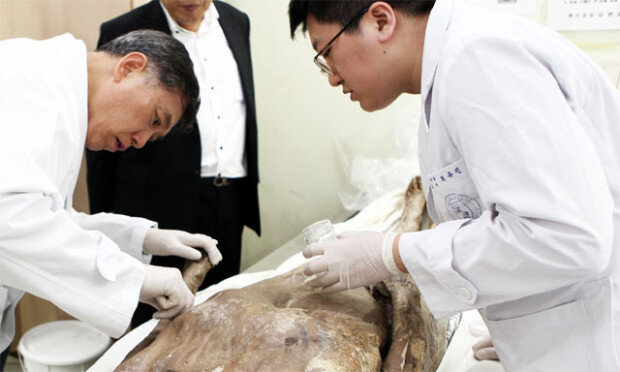Parasites found for the first time in a Joseon mummy
Parasites found for the first time in a Joseon mummy
Posted September. 21, 2018 08:05,
Updated September. 21, 2018 08:05

For the first time in Korea, paragonimus westermani (a parasite that lives off the lungs of mammals) and its larvae have been discovered in the lungs of a mummy from the Joseon Dynasty. It is extremely rare to discover a parasite in the lungs of mummy. So far, scientists believed that tubercular bacillus have been the main cause behind hemoptysis (coughing up blood), but the recent discovery has suggested that paragonimus westermani could have been the culprit. People can be infected by paragonimus westermani after eating crab, lobster and freshwater fish raw or undercooked, which causes hemoptysis and pain in the chest.
The research team led by Professor Kim Han-gyeom of the pathology department at the Guro Hospital of Korea University announced the discovery of mummified paragonimus westermani and numerous larvae in the left lung of a mummy found in Uijeongbu City of Gyeonggi Province in 2016. The imago, which had eggs, was 5 mm in width while the egg has 0.08 mm long. The research team dissected the mummy’s lung into some 80 pieces and observed the pieces under a microscope for more than a year.
“King Seongjong, Heonjong and Cheoljong of the Joseon Dynasty have been known to die from tubercular bacillus. However, the disease is mostly caught by people who have bad nutrition health, which is unlikely for kings,” explained Professor Kim. "Our discovery shows that just because kings coughed up blood before they passed away, it could not be concluded that they had suffered from tubercular bacillus."
The mummy, dubbed as Kim Eui-jeong, is the body of a male found in 2016. The Departments of Pathology and Anatomy at the medical school of Korea University and the National Forensic Service have worked together for over the past two years to understand the health condition and death cause of the corpse.
The mummy is estimated to be around its 40s at the time of death with an overweight body and appears to have suffered from symptoms of central obesity, fatty liver, hepatocirrhosis and arteriosclerosis. The cause of the mummy’s death is estimated to be lung damage due to paragonimus westermani, hepatocirrhosis and heart disease.
Jin-Han Lee likeday@donga.com







